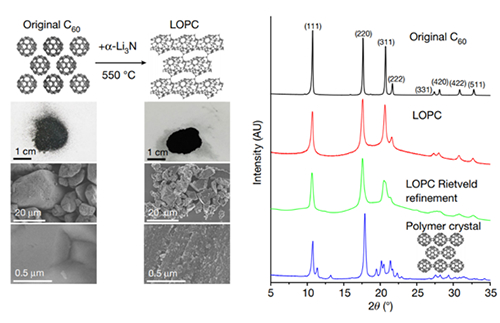
Figure. Morphology and structure characteristics of face-centered cubic C60 molecular crystal, C60 polymer crystal and LOPC crystal.
Supported by the National Natural Science Foundation of China (Grant Nos. 51972299, 52003265), Professor Yanwu Zhu’s group in the University of Science and Technology of China has made progress in the preparation of novel carbon crystals. The research was published in Nature on January 12, 2023, with the title “Long-range ordered porous carbon produced from C60”. (Article link: http://www.nature.com/articles/s41586-022-05532-0).
Carbon atoms form crystals such as graphite and diamond via different hybridizations, leading to distinct properties and applications. Based on the sp2 hybridization, carbon atoms can also be assembled into several well-known nanostructures such as fullerenes, carbon nanotubes, graphene and graphdiyne, from which more interesting properties are defined. Recent progress in carbon materials indicates that carbon crystals can be prepared starting from fullerenes, which have a well-defined structure, demonstrating a more rational preparation for architectural carbons. However, in the previously reported research based on fullerenes, the yield of the final carbon crystals is typically low yet with much impurity; it is challenging to obtain carbon crystals with well-controlled structures and tunable properties that can be used for systematic characterizations and extensive application studies.
Based on the previous research, Zhu’s group has utilized a method of charge injection to fullerene C60 molecular crystal with lithium nitride (α-Li3N), for the transformation of intermolecular interface in the atomic-level precision. At ambient pressure and 440-600 ℃, the face-centered cubic C60 molecular crystal is transformed to C60 polymer crystal and LOPC crystal, on a gram scale, as shown in the Figure. Through the collaboration of research groups from Southeast University, China Spallation Neutron Source, National Synchrotron Radiation Laboratory, Southern University of Science and Technology, Institute of Semiconductors of the Chinese Academy of Sciences, Institute of Basic Sciences in Republic of Korea, the microstructures, spectral features, fine electronic structures and electrical properties of LOPC have been systematically characterized. The research indicates that a dipole is introduced by the charge injection into the C60 molecule, which may propagate along certain direction in C60 molecular crystal, resulting in the lower reaction barrier of cycloaddition reactions between C60 molecules. Further reactions (higher reaction temperature, more charge injection, longer reaction time) transform the intermolecular sp3 connection into curved sp2 structure, but the positions of C60 cages maintain good long-range order, as shown in the Figure below.
This research has largely expanded the preparation technique of novel artificial carbon crystals and provided new insight for exploring the structure of more diversified carbon crystals.

Add: 83 Shuangqing Rd., Haidian District, Beijing, China
Postcode: 100085
Tel: 86-10-62327001
Fax: 86-10-62327004
E-mail: bic@donnasnhdiary.org
京ICP备05002826号 文保网安备1101080035号 Copyright 2017 NSFC, All Right Reserved